Suspended Animation
The sub-microscopic dramas narrated in Tacita Dean’s 1997 film The Structure of Ice hover between science and love story:
‘Atoms are in constant motion. They touch and turn and move by mutual collisions and blows. And as they move they collide and become entangled in such a way as to cling in close contact with one another…’.
Her voiceover chronicles the promiscuous rushings and swirlings of atoms, now bonding, now repelling each other in a Dionysian mist. There is a ‘hooked’ atom that exercises a kind of erotic cling. ‘Fire’ atoms join forces with vibrating ‘soul’ atoms.
How romantic. And how seemingly distant from the object on the screen. It looks like a chemist’s ball and stick model – the kind I first encountered at school and never could connect to the thing it modelled, like water or graphite. Always a familiar substance I thought I knew, shattered beyond recognition into marbles and rods. This one is a model of the structure of atoms in ice.
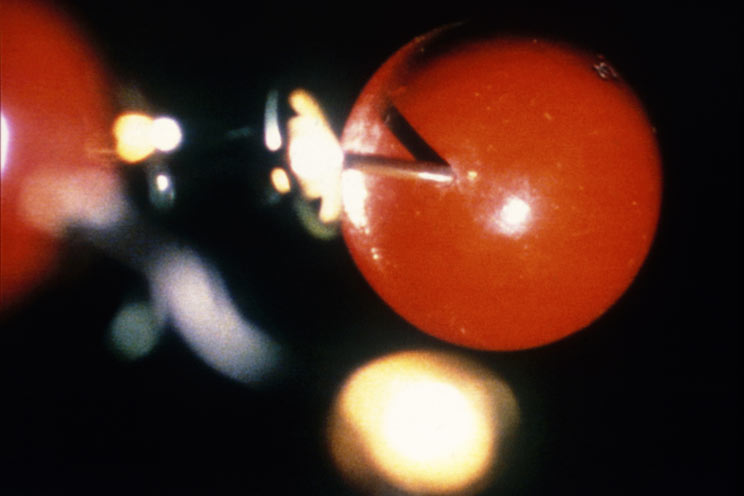
still from Tacita Dean’s The Structure of Ice (1997) Commissioned by the Science Museum
The camera focuses on a red sphere frozen in place by a metal spoke. If a static network of balls and sticks forged in wood and metal is distant from the impassioned atoms of Dean’s voiceover, it is also a far cry from the experience of actual ice. To human touch, ice is always prone to change, just on the cusp of melting, cracking or fusing. Ice is also the substance of the Romantic imagination (with a definitive capital -‘R’ this time), from Caspar David Friedrich’s Wreck of Hope, or The Sea of Ice, to the desperate final scenes of Mary Shelley’s Frankenstein that see the monster fleeing into the Arctic white-out1. The poetry of distance in these images is also found in Dean’s The Structure of Ice: as I watch it, I understand the pathos at the heart of these models, their crude attempts at halting and schematising something so ungraspable as the sub-visible units of matter.
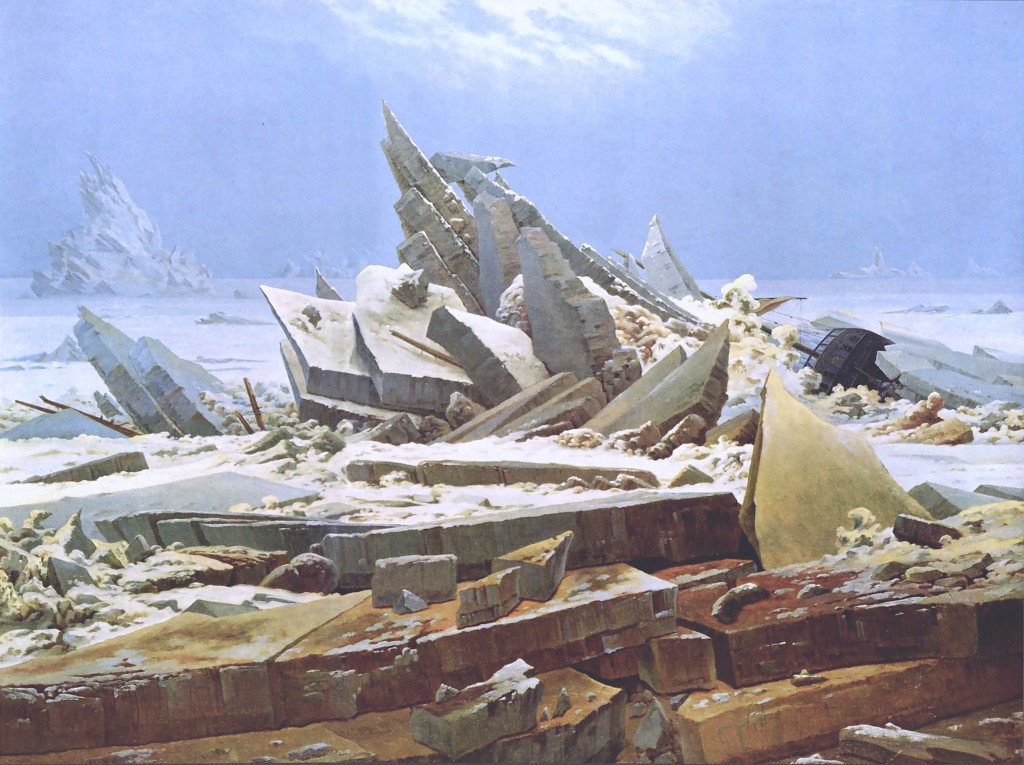
Caspar David Friedrich’s Wreck of Hope (1823-1824), from WKC
But there is something slightly different about this model. Beneath the rippling voiceover, it keeps time with a persistent click, clack, click, clack – the switching on and off of a light. All along its spokes this structure of ice is wound up with electrical equipment like an informant wearing a wire. Some of its ‘atoms’ are not pictured by the wooden spheres I remember collecting dust in the back of the chemistry classroom. Instead, they are light bulbs. In Dean’s film, shot in the dark, they perform a continuous binary flicker.
Designing fictions
I first encountered this model as a shadowy jumble of wires and rods deep in one of the cavernous storerooms of Blythe House, the old headquarters of Britain’s Post Office Savings Bank, which now houses the thousands of artefacts held but not displayed by London’s Science Museum. The ice model was made almost half a century earlier for the chemist Kathleen Lonsdale. At the time, she was one of a few pioneers practicing the relatively new technique of X-ray crystallography, which allowed scientists to imagine and map out the tiny atomic architecture of matter that was invisible to the eye or microscope. Lonsdale was also one of an even smaller contingent of female scientists at the time, many of whom worked with X-ray crystallography. It was this, coupled with the painstakingly detailed work that the technique required of its practitioners, that led some to dismiss X-ray crystallography as so-called ‘intellectual knitting’2.
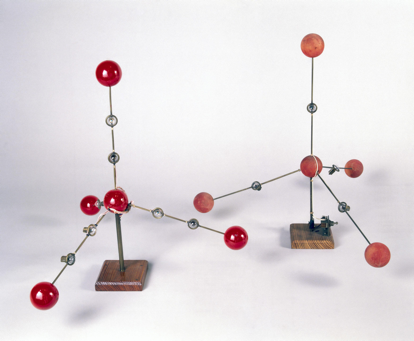
Kathleen Lonsdale’s models of the structure of the ice, c.1955 © Science Museum, London.
When water freezes, it doesn’t only transform from a liquid into a solid – it becomes a mineral, making ice a convenient subject matter for a crystallographer. The word ‘crystal’ itself comes from the Greek term for ice, making crystallography a linguistic fossil of the ancient belief that crystals are actually frozen liquid hardened underground by the pressure of the surrounding earth. Over time, crystallography has variously been interwoven with mysticism, animism and early scientific meditations on the physical world. The eighteenth century scientist and mystic Emanuel Swedenborg, for instance, both reported on his communications with angels and contributed to early science on the structure of matter, prompted in part by crystallography. To him the crystal was an interface between a rather amorphous realm of infinite mystery and the visible ordered world that ushered from it3. Of course, all of his material reveries took place from the outside of a crystal’s facets, gazing in. For most of the history of crystallography in fact, observers were limited to studying the external forms of crystals, speculating at the deep ordering principles at work within them.
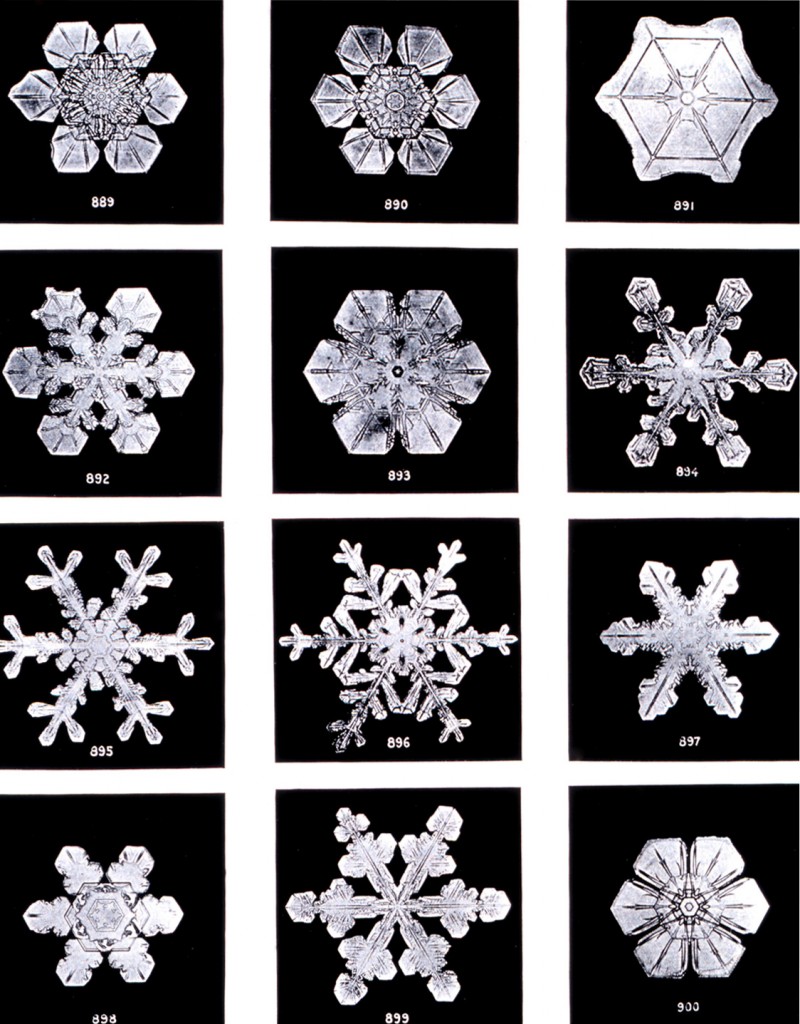
Wilson Bentley’s photographs of snowflake crystals, 1902
In the early teens of the twentieth century, however, following the German physicist Wilhelm Röntgen’s discovery of the X-ray, crystallographers found a way to penetrate deeper into crystals. Moving between the atoms of a crystal with the miniscule waves of X-rays, they could pry inside, no longer halted at its hard exterior faces. This was the beginning of X-ray crystallography.

‘Snowflakes’ from the poet Christian Bök’s Crystallography (Toronto: Coach House Books, 2003), 95. Part of the chapter ‘The Hagiography of Snow’.
It was a deeply visual technique. The first stage involved the creation of a photograph, one that was imaged not with visible light but with X-rays. These X-rays were shot at a crystallised substance, like blood, ice or nylon (by this time, crystallographers had moved beyond minerals to organic and even synthetic matter). The rays would diffract inside the crystal, or ‘break apart’, as they ricocheted off atoms, leaving their imprints, an abstract pattern of dots and lines, on a photographic plate on the other side.
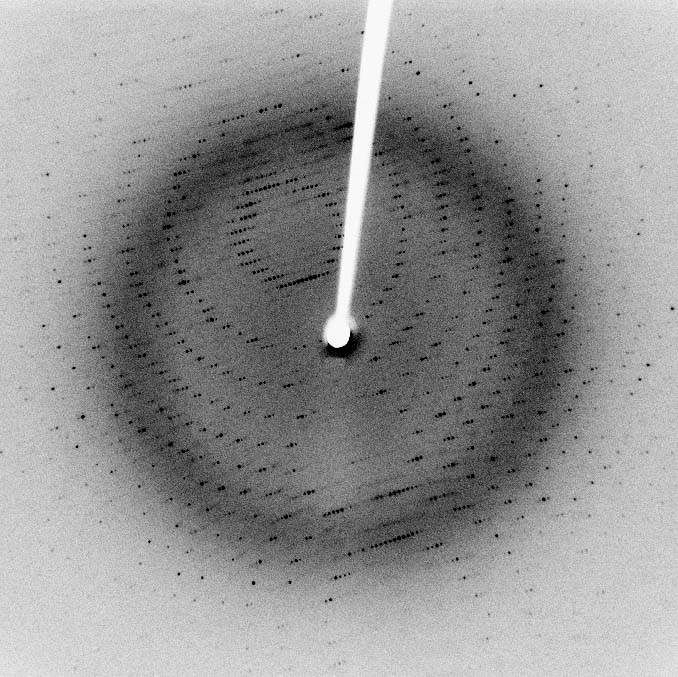
An X-ray diffraction photograph of a protein from the SARS virus made in 2006 by Jeff Dahl
Scientists like Lonsdale worked backwards from these photographs, a tedious process of calculations (sometimes taking years) and trial-and-error model building, as they imagined the original array of atoms that caused the patterns on the film. I think of crystallographers as early comers to the encoded or algorithmic world so familiar to many of us today. As the crystallographer and political activist J.D. Bernal wrote in 1967, ‘Life is beginning to cease being a mystery and becoming […] a cryptogram, a puzzle, a code’4
Theirs was a universe of matter smaller than the wavelength of visible light, so it was completely non-visible. Crystallographers designed a material language for thinking about this non-visible realm – one made of the chemist’s balls and sticks, as well as plasticine foldings, skeletal networks of wire, and geodesic orbs made of children’s toys. These are not merely scaled-up copies of the atomic scale as it would look if they could have in fact seen it, but entirely new forms themselves: crystallography embraces the unrepresentable. I think it is an embrace that can really only be captured poetically. In his book Crystallography, the Canadian poet Christian Bök provides his own reading of the technique: ‘X-rays illuminate black bodies with a light that no one sees, the sound of its flicker preserved in the shape of its silence’5.
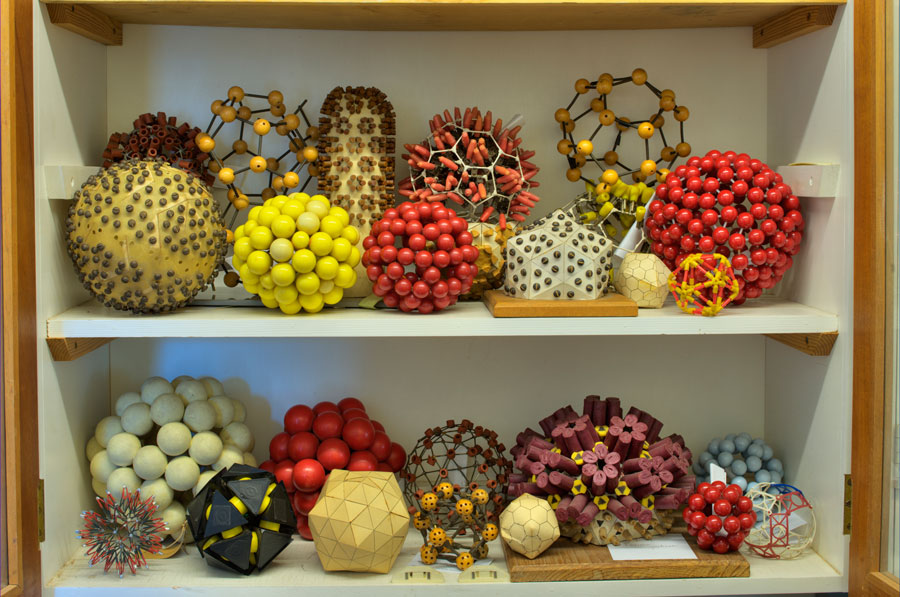
Crystallographers’ virus models, geodesic orbs (© MRC Laboratory of Molecular Biology)
X-ray crystallography, as it was practiced by scientists like Lonsdale by 1955, had moved far away from the crystallography of eighteenth century mystics, but it still trafficked in the interface of the visible and the unknown. Lonsdale’s model of ice structure, with its persistent flicker, is itself symbolic of how scientists designed for data at this interface. Its red wooden ball oxygen ‘atoms’ are linked with hydrogen ‘atoms’, which were cast as blinking lights – probably to reflect what was at the time the elusive positions of hydrogen atoms in ice. The known is tethered to the unknown. This model, like all crystallographers’ models, is more metaphoric structure than straight representation of some idea of ‘nature’ stripped bare by the scientist. As ingenious material metaphors, novel forms, designed for understanding fragments of information about the invisible, the structures composed by crystallographers are a kind of fiction. They have to be.
Atomic ‘its’
Crystallographers are not the only ones to imagine atoms using the tools of fiction. The elusiveness of an individual atom, its capacity for bonding, severing ties and reassembling into new configurations makes it perfect ‘‘it’ narrative’ material. The ‘it’ narrative was a small genre of fiction that developed in the eighteenth century, spawning novels that chronicled non-human protagonists – a coin or a pin, for example – circulating through the human world on a semi-animate lifecourse. In the British author Tobias Smollett’s The History and Adventures of an Atom, published in 1769 as a biting political satire of the Seven Years War, the story is dictated to a haberdasher named Nathaniel Peacock by an atom lodged in his pineal gland. The atom begins by relating his meandering path from Japan (which stands in for England in the story) to Nathaniel’s brain. It is a series of identity-shifting trans-generational ‘transmigrations’ through various animals, objects and digestive systems:
‘I was enclosed in a grain of rice, eaten by a Dutch mariner at Firando, and, becoming a particle of his body, brought to the Cape of Good Hope. There I was discharged in a scorbutic dysentery, taken up in a heap of soil to manure a garden, raised to vegetation in a sallad [sic], devoured by an English supercargo, assimilated to a certain organ of his body, which, at his return to London, being diseased in consequence of impure contact, I was again separated, with a considerable portion of putrefied flesh, thrown upon a dunghill, gobbled up, and digested by a duck, of which duck your father, Ephraim Peacock, having eaten plentifully at a feast of the cordwainers, I was mixed with his circulating juices, and finally fixed in the principal part of that animalcule, which, in process of time expanded itself into thee, Nathaniel Peacock’6.
Smollett took evident glee in the humorous possibilities of an atom’s passage through so many human bodies, the often-grisly functions of which propel it along its course. But this constant passage also makes the atom a convenient omnipotent narrator (its omnipotence born, ironically, of its utter smallness). And reasoning with Nathaniel, persuading him to take dictation, this atom is rather human as well, more seaworthy stowaway than mindless parasite.
A very different atomic wanderer runs through Carbon, a 1975 short story by chemist and writer Primo Levi, most well known for his book If This Is a Man on his imprisonment at Auschwitz. At the roving centre of this tale is a single atom of carbon. Levi begins with the stretch of millions of years the atom spends underground as part of a chunk of limestone, although for an atom, as Levi points out, ‘time does not exist’ of course. Here ‘it is congealed in an eternal present, barely scratched by the moderate quivers of thermal agitation’7. It is eventually pried from the ground by a pickaxe and heated in a kiln where it becomes dislodged from its one-time neighbouring calcium atoms and released through a chimney into the air. It undergoes countless material vicissitudes, moving in and out of foliage, wine, and a tree trunk before it is belayed by the wind, now as carbon dioxide.
Unlike the story told by the affable atom prattling on inside Nathaniel Peacock’s brain, Levi’s narrative reveals a desire for another point of reference, one outside the human-centred world: that of matter itself.
But both atomic ‘it’ narratives never quite dislodge themselves from a human point of view. Even in Levi’s story, we discover at the very end that his carbon atom has been subject to the same fate as Smollett’s atom – it is in the author’s brain! Levi swallows the carbon atom in a glass of milk, admitting it into the network of substances and forces that ‘guides this hand of mine to impress on the paper this dot, here, this one.’8 Carbon is nevertheless a rare and beautiful speculation upon a parallel reality, that of things, where our familiar experiences of time and material relationships, movement and identity are not applicable, and a kind of chemical imagination must intervene if we are to imagine it at all.
I am reminded of the recent ‘object oriented philosophy’ of sports journalist turned philosopher Graham Harman. Why limit ourselves to what our minds have access to, that is, our human consciousness of things? Harman calls for a speculation beyond this, as one of a number of thinkers currently shaping the philosophical approach known as ‘speculative realism’. It shifts the spotlight away from the anthropocentric universe:
‘Red billiard ball smacks green billiard ball. Snowflakes glitter in the light that cruelly annihilates them, while damaged submarines rust along the ocean floor. As flour emerges from mills and blocks of limestone are compressed by earthquakes, gigantic mushrooms spread in the Michigan forest’.
Simply because our senses don’t allow us into the phenomenological experience of a billiard ball or block of limestone does not mean that writers, designers, artists like Tacita Dean or philosophers like Harman cannot speculate upon them or empathise with them in a productive way. Harman is right that typically ‘we are asked to leave all of this to the physicists alone’9. The speculative possibilities of fiction writing or interaction design for instance do not intersect directly with those of scientific research (and I think the tensions between these areas can be more fertile than the constant search for ‘parallels’). It also can’t hurt, however, to stick for just another moment with the scientists, to draw upon their own modes of speculative thinking and material imagination. These are the things that might not always make it into scientific journal articles, but which appear in places like the speculative models of atomic architecture designed by crystallographers working at the interface of what it was possible to identify and what was beyond their reach.
An ‘it’ for the Atomic Age
When Lonsdale’s ice model appeared in the 1950s, its flickering hydrogen atoms may as well have stood for the uncertainty of an entire era. Previous notions of material solidity and security had been swiftly undermined by the splitting of the atom and the devastating use of the atomic bomb only a few years earlier. The post-war atom was a fragmented ‘it’, torn between the dystopian spectre of atomic warfare and utopian hopes for atomic energy, the latter often trotted out to deflect anxieties about the potential of nuclear destruction. A seam of startlingly light evocations grew up in between, from home appliances branded with the word ‘atomic’ to automobile engineer Louis Réard’s new miniscule swimwear named the ‘bikini’ after the location in the Micronesian Islands where the US conducted atomic bomb tests. Just as Smollett’s and Levi’s fictional atomic ‘its’ quartered themselves in the brains of their narrators, the Cold War-era atom also took up residence in a collective brain cavity, this time not as an affable storyteller or neutral unit of matter, but as an oppressive mushroom cloud: Herbert Matter’s Atomic Head photocollage for the December 1946 cover of Arts and Architecture magazine pictures this ‘it’ for the Atomic Age as a kind of psychic parasite.
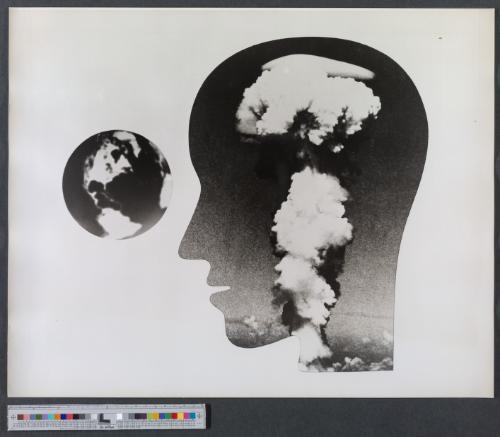
Herbert Matter Atomic Head; Arts & Architecture cover, December 1946
Dissolving structures
‘And then they stay together to become compound bodies until such time as stronger necessity comes from the surroundings and shakes and scatters them apart’.
Dean’s voiceover is of course a fiction. It is based on the imaginative theories of the Greek atomists Leucippus and Democritus with shades of inter-atomic romance drawn out by the artist. It speaks to the wider story of the atomic – one of constant transformation, splitting, dissolution and union, as changeable as ice itself. Dean’s is a point in a constellation of atomic fictions that all emerge from a similar impulse: the idea of an atom prompts the human imagination to lose its point of reference, to exit the scale, perspective and interactions most of us are so used to that we hardly notice. To reach into the spaces between what is available to our senses, and towards the flickering presence of the speculative realities that grow up there.
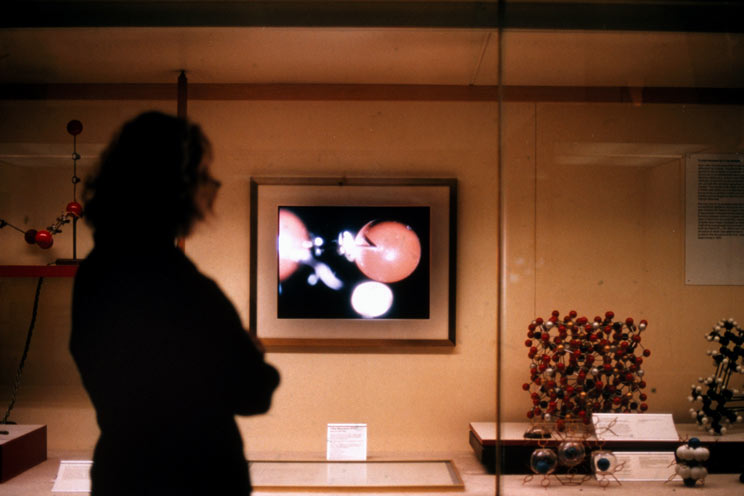
installation view of Tacita Dean’s The Structure of Ice (1997) Commissioned by the Science Museum
- Eric G. Wilson, The Spiritual History of Ice: Romanticism, Science, and the Imagination [New York: Palgrave Macmillan, 2003] [↩]
- Maureen M. Julian, ‘Women in Crystallography’ in Women of Science: Righting the Record, ed. by G. Kass-Simon and Patricia Farnes [Bloomington: Indiana University Press, 1990], 335 [↩]
- Wilson, ‘Thoreau, Crystallography, and the Science of the Transparent’, Studies in Romanticism, 43, no. 1 (2004), 99-117, 101 [↩]
- J. D. Bernal, ‘Definitions of Life’, New Scientist 3 (13) (1967), 13 [↩]
- Christian Bök, Crystallography (Toronto: Coach House Books, 2003), 130 [↩]
- Tobias Smollett, The History and Adventures of an Atom (Athens, Georgia: University of Georgia, 1989 [1769]), 7 [↩]
- Primo Levi, ‘Carbon’ in The Periodic Table (London: Penguin, 2000), 189 [↩]
- Levi, 195 [↩]
- Graham Harman, ‘Object-Oriented Philosophy’ in Towards Speculative Realism: Essays and Lectures (Ropley, Hampshire: Zero, 2010), 94 [↩]